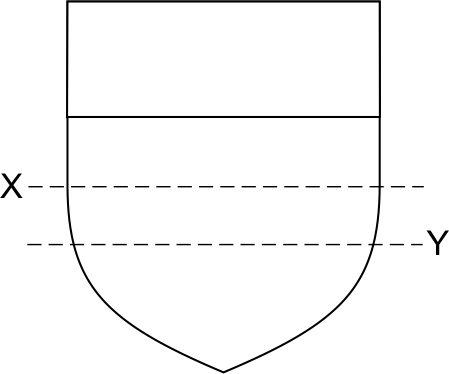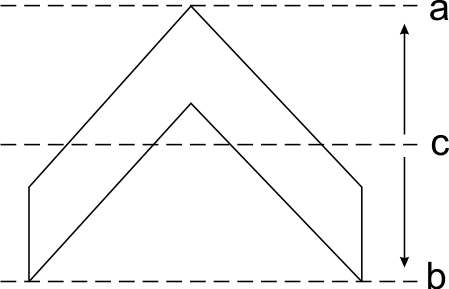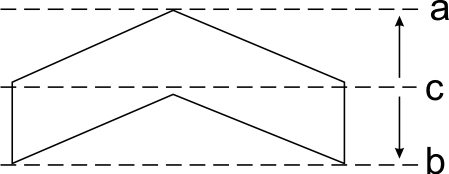
Figure 1
Society for Creative Anachronism
College of Arms
For the May 2011 meetings, printed Wednesday, July 13, 2011
To all the College of Arms and all others who may read this missive, from Elisabeth Laurel, Istvan Wreath, and Juliana Pelican, greetings.
Items listed below in square brackets have not been scheduled yet. For information about future scheduling, please review the status table located on the Web at http://oscar.sca.org/index.php?action=137.
The May Laurel decisions were made at the Wreath meeting held on Saturday, May 14, 2011 and at the Pelican meeting held on Sunday, May 22, 2011. These meetings considered the following letters of intent: Caid (27 Jan, 2011) (pushed due to lack of packet) , Laurel LoPaD (08 Feb, 2011), East (09 Feb, 2011), Atenveldt (15 Feb, 2011), Middle (22 Feb, 2011), Caid (27 Feb, 2011), Lochac (27 Feb, 2011), An Tir (28 Feb, 2011), Ansteorra (28 Feb, 2011), Drachenwald (28 Feb, 2011), Gleann Abhann (28 Feb, 2011), Outlands (28 Feb, 2011), Trimaris (28 Feb, 2011), and West (28 Feb, 2011). All commentary, responses, and rebuttals should have been entered into OSCAR by Saturday, April 30, 2011.
The June Laurel decisions were made at the Wreath meetings held on Saturday, June 4, 2011, at the Pelican meeting held on Sunday, June 19, 2011, and at the Known World Heraldic & Scribal Symposium roadshow on Sunday, June 26, 2011. These meetings considered the following letters of intent: Meridies (28 Feb, 2011) (pushed due to lack of packet), Laurel LoPaD (10 Mar, 2011), West (15 Mar, 2011), Atenveldt (20 Mar, 2011), Ęthelmearc (21 Mar, 2011), Atlantia (23 Mar, 2011), Atlantia (24 Mar, 2011), East (24 Mar, 2011), Ansteorra (26 Mar, 2011), Calontir (27 Mar, 2011), Lochac (28 Mar, 2011), An Tir (31 Mar, 2011), Artemisia (31 Mar, 2011), and Outlands (31 Mar, 2011). All commentary, responses, and rebuttals should have been entered into OSCAR by Tuesday, May 31, 2011.
The July Laurel decisions will be made at the Wreath meeting held on Saturday, July 9, 2011 and the Pelican meeting held on Sunday, July 24, 2011. These meetings will consider the following letters of intent: Caid (29 Mar, 2011) (pushed due to lack of packet) Drachenwald (03 Apr, 2011), West (08 Apr, 2011), Atenveldt (15 Apr, 2011), Trimaris (20 Apr, 2011), Laurel LoPaD (23 Apr, 2011), Ansteorra (26 Apr, 2011), Meridies (27 Apr, 2011), Gleann Abhann (28 Apr, 2011), Laurel LoPaD (29 Apr, 2011), Lochac (29 Apr, 2011), Middle (29 Apr, 2011), Atlantia (30 Apr, 2011), Calontir (30 Apr, 2011), Drachenwald (30 Apr, 2011), and Outlands (30 Apr, 2011). All commentary, responses, and rebuttals should have been entered into OSCAR by Thursday, June 30, 2011.
The August Laurel decisions will be made at the Pelican and Wreath meetings held in August 2011. These meetings will consider the following letters of intent: Caid (30 Apr, 2011) (pushed due to lack of packet), Northshield (09 May, 2011), An Tir (11 May, 2011), Ęthelmearc (12 May, 2011), West (15 May, 2011), Atenveldt (20 May, 2011), East (21 May, 2011), Middle (23 May, 2011), [An Tir (27 May, 2011)], Meridies (27 May, 2011), Ansteorra (28 May, 2011), Lochac (29 May, 2011), Outlands (29 May, 2011), [Artemisia (30 May, 2011)], Gleann Abhann (30 May, 2011), Atlantia (31 May, 2011), Drachenwald (31 May, 2011), and Ealdormere (31 May, 2011). All commentary, responses, and rebuttals should be entered into OSCAR by Sunday, July 31, 2011.
The September Laurel decisions will be made at the Pelican and Wreath meetings held in September 2011. These meetings will consider the following letters of intent: [Middle (05 Jun, 2011)], Laurel LoPaD (07 Jun, 2011), [Ęthelmearc (08 Jun, 2011)], [East (16 Jun, 2011)], [Atenveldt (20 Jun, 2011)], Caid (22 Jun, 2011), [Drachenwald (28 Jun, 2011)], [Meridies (28 Jun, 2011)], [Caid (29 Jun, 2011)], [Lochac (29 Jun, 2011)], [Trimaris (29 Jun, 2011)], [An Tir (30 Jun, 2011)], [Ansteorra (30 Jun, 2011)], [Calontir (30 Jun, 2011)], [Gleann Abhann (30 Jun, 2011)], Laurel (30 Jun, 2011), and [Outlands (30 Jun, 2011)]. All commentary, responses, and rebuttals should be entered into OSCAR by Wednesday, August 31, 2011.
Not all letters of intent may be considered when they are originally scheduled on this cover letter. The date of posting of the LoI, date of receipt of the Laurel packet, or other factors may delay consideration of certain letters of intent. Additionally, some letters of intent received may not have been scheduled because the administrative requirements (receipt of the forms packet, receipt of the necessary fees, et cetera) have not yet been met.
REMINDER: Until all administrative requirements are met, the letter may not be scheduled.
Many thanks to Barunin Gisela and her talented crew for making this year's KWHSS most enjoyable. The class selection was very good and the arrangements made for hospitality and airport transfers were particularly appreciated. For my part, this was my first trip to Atlantia and I an already looking forward to the next.
As already announced at the roadshow, next year's KWHSS will be in the Barony of the Bridge (Warwick, RI) in the Kingdom of the East on June 22-24, 2012. The complete text of the bid can be seen on OSCAR. I hope to see you there.
As of August 1, all material in the submissions packets must be scanned by the kingdom submissions heralds and the scans sent to Ragged Staff.
For some time now, scanning armory for OSCAR has been required. To enter the black and white outline and color pictures, you have to 'crop' or take away all personal information. This will not change.
Scanning the entire packet to send to Ragged Staff prior to mailing the paper is actually easier - simply scan all the paper as it will go into the envelope, no cropping or trimming necessary. Only one color copy of armory is scanned. The settings are the same as the archive scanning project, so that we can transfer the scans over at any time - scan at 300 dpi and save as jpg. The naming conventions for the individual pages are also simple - first name of the individual followed by an underscore and then the type of form. Capitalize the first letter and make sure that there are underscores between each part of the file label. The lack of spaces is necessary for some of the automated sorting and renaming processes.
Sample naming:
John_name.jpg
John_name0001.jpg (first page of doc, if any)
John_name0002.jpg (second page of doc, etc)
John_device.jpg
If there is something specific like a change of holding name or heraldic will, spell that out enough to make it clear what it is:
Jane_holding_name_change.jpg
Jane_will.jpg
Jane_letter.jpg (this can be any of a variety of letters - be specific if you feel it necessary)
If you have any questions, please direct them to Ragged Staff or to me as appropriate.
After a successful and extremely hard working tenure, Istvan Wreath has stepped down to enjoy a probably even harder working retirement. I am very pleased to welcome the new Wreath Queen of Arms, Magistra Emma de Fetherstan of the Kingdom of Ansteorra. She has already shown herself to be a valuable member of the Laurel team, and we are glad to have her with us.
Latin plays a curious role in the way we talk about names (and in terms of what combinations we allow for registration). That's because Latin and how it is used changes across our period. You'll often see terms like "Latinized" that will, I hope, make a little more sense when this is done.
In Roman times, a language we call Latin or Classical Latin, was the everyday language people spoke. You can find dictionaries of it online, such as Lewis and Short's dictionary found at http://www.perseus.tufts.edu/hopper/text?doc=Perseus:text:1999.04.0059. Over time, different dialects and less learned forms developed; we call them as a group Vulgar Latin. As the Roman Empire fell apart in the 5th century, the kinds of Vulgar Latin became more different, until finally we start calling them Romance and then French, Italian, Spanish, and the like. But that's a story for another day.
While Latin fell out of use as an everyday spoken language, it remained a language of the government and the church. Thus, names continued to be recorded in Latin, although the names were not themselves Latin in content (remembering that Latin has given way to Romance languages). Even in areas that had never been Latin-speaking, Latin became the language of record for much of the Middle Ages (though this is not true of Russia and parts of Eastern Europe).
Therefore, we can talk about names being recorded in vernacular forms, which render the names in the way they would have been spoken in the everyday language (English, French, etc.) spoken in a region, and in Latinized forms, which render the names in Latin. The relationship between vernacular and Latinized forms is complicated: some vernacular names are derived from old Latin names (or by names originally from Greek, Hebrew, etc., that are transmitted through Latin), while others never appeared in classical Latin. Some Latinized forms are quite similar to the vernacular forms: Robert is recorded in Latin as Robertus and Edith is recorded as Editha. Others are more distant from their vernacular forms: Giles is recorded in Latin as Egidius, John is recorded as Iohannes, and Denis is recorded as Dionysius. In some cases, these names are etymologically linked; in other cases, the associations between the vernacular and Latinized forms are unclear. Some names are even treated as strange undeclinable forms (a declension is just a fancy word for the changes to a word as it does different things in a sentence, like they/them/their), and are used in Latin contexts with no changes to the root name. That means that it can be hard for a submitter to determine from a Latinized form what the vernacular should be (and vice versa).
We will register Latin names from the classical period, but most of the "Latin" names we register are Latinized forms of names in some language. These names can be registered in completely vernacular forms, completely Latinized forms, or in mixes of vernacular and Latinized forms. That's because we can find records for most places that have completely Latinized forms, mostly vernacular forms, or some mix (most commonly Latinized given names and vernacular bynames, but other mixes are found too). We can often construct a Latinized form from a vernacular form of a name, or vice versa. But we can only do that when we have enough information about both vernacular and Latinized names in that language; thus we often cannot do that for the cultures that did not continue after Roman times.
For purposes of lingual mixes, Latin is its own language when we're talking about the classical stuff. But by the Middle Ages, that's not true. Latinized English is English: records written down in Latin by English speakers recording everyday information are considered linguistically English for purposes of determining possible lingual mixes. This is true even when the elements are identical to those used in classical Latin. Similarly, Latinized Italian is considered Italian, Latinized German is considered German, etc. Of course, some Latinized elements will be the same across time and space: for example, Iulianus first appears as a Latin cognomen, but will be used to render medieval English Julian, French Julien, Italian Giuliano and other names across Europe. But you cannot take a Latinized example from French and assume without documentation that a similar form is justifiable in German, for example.
On the Cover Letter for the December 2010 LoAR, published in February 2011, we asked commenters for their opinions on a proposal regarding more proper depictions of chevrons, the per chevron line of division, and their inversions. We proposed putting strong limitations on charges above the tip of a chevron or a per chevron line of division, or below the tip of a chevron inverted or a per chevron inverted line of division.
Many examples were presented of charges above a chevron or per chevron line of division, or below the point of a chevron inverted or per chevron inverted line of division in period heraldry, so we will not be limiting that practice.
Examples provided in commentary did present evidence that in period, chevrons and the per chevron line of division were typically drawn to take up as much space as possible; this generally meant that the line was fairly steep, throughout, or nearly so. However, in some heraldic jurisdictions, the chevron was much shallower. Therefore, we will not regulate the steepness of chevrons or the per chevron or per chevron inverted lines of division at this time.
What was found, however, was that in every case, the chevron or per chevron line was vertically centered in the area available to it, taking the placement of any secondaries present into account. The notional mid-line of the charge or line of division would nearly always line up with a per fess line drawn centered on the available space.
Pictures help: Notice that on the escutcheon attached as figure 1, the dashed line X is the per fess line of the entire escutcheon. However, in the presence of the chief, the available space has a notional mid-point line marked by the dashed line labeled Y. Similarly, both chevrons (figures 2 and 3) have a notional mid-point line at c, and the distance above the mid-line (a) and below it (b) should be the same.

Figure 1

Figure 2

Figure 3
The following guidelines on chevrons and per chevron field divisions, and their inversions, will be enforced starting at the November 2011 Laurel meetings:
Per chevron lines of division, chevrons as a primary charge, and their inversions should have their mid-line placed roughly on the notional mid-line of the space available to them.
If substantially more of the charge or line appears to be on one side of the field's notional mid-line as compared to the amount on the other side, the submission will be returned for a redraw or re-design.
Chevrons etc. move based on the position of secondaries: allowances will be made for times when the charges around or above and below interfere with the placement. A chevron etc. between three charges should be in the same place on the field as a chevron with no charges on the field, but a chevron below a single charge fesswise, or a chevron below a group of charges in fess, may be further down the field. A chevron etc. placed above a single charge or group of charges in base may be further up on the field.
The end result is that per chevron lines of division alone on the field, or between three charges, should not be entirely, or even mostly, below where a per fess line would be. Chevrons which are shallow enough to be confused with a fess remain unregisterable.
More information on the research that led to this decision, including a large number of period exemplars, can be found in the article "A Visual Survey of the Chevron and Friends: Fun with Triangular Field Divisions" by Emma de Fetherstan in the Proceedings of the 2011 Known World Heraldic and Scribal Symposium.
Letters of Intent, Comment, Response, Correction, et cetera are to be posted to the OSCAR online system. No paper copies need be sent.
Submission packets (one copy of each name form plus documentation, including petitions; two colored copies of each armory form plus two copies of any associated documentation, including petitions) to the SCA College of Arms, PO Box 31755, Billings, MT 59107-1755.
Cheques or money orders for submissions, payable to "SCA Inc.-College of Arms" are to be sent to David Duggar, Attn: Laurel Chancellor of Exchequer, 1705 Holiday Pl, Bossier City, LA 71112-3706.
Send roster changes and corrections to Laurel. College of Arms members may also request a copy of the current roster from Laurel.
For a paper copy of a LoAR, please contact Laurel, at the address above. The cost for one LoAR is $3. Please make all checks or money orders payable to "SCA Inc.-College of Arms". The electronic copy of the LoAR is available free of charge. To subscribe to the mailings of the electronic copy, please see the bottom of http://heraldry.sca.org/heraldry/lists.html#lists for more instructions.
For all administrative matters, please contact Laurel.
Pray know that I remain,
In service,
Elisabeth de Rossignol
Laurel Principal Queen of Arms
Created at 2011-07-13T22:30:43